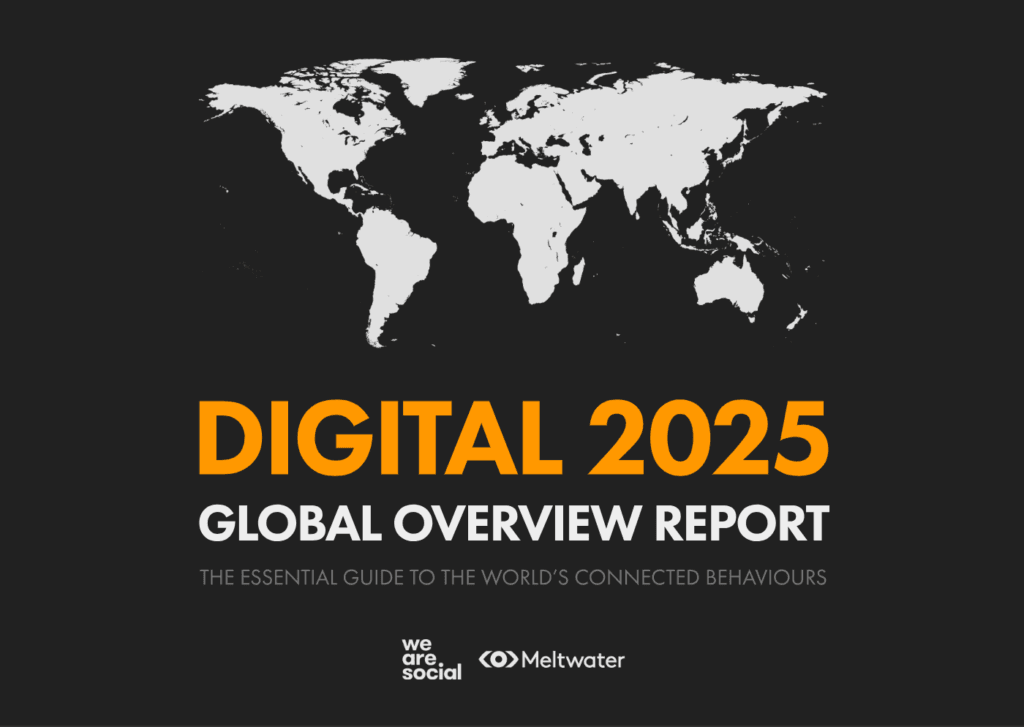8 Key Insights on Global Connectivity: Mobile Penetration, Internet Usage, E-Commerce, and Social Media Trends

The below FAQ is discusses the report published recently by “Meltwater” and “We Are Social” titled “Digital 2025 Global Overview Report“. The report offers a comprehensive look at the evolving digital landscape.
1. What is the global landscape of mobile connectivity in relation to population size, and which countries show the highest penetration rates?
The report shows a comparison of cellular mobile connections to total population across numerous countries. While specific countries and percentages vary, the data indicates many nations have mobile connectivity rates exceeding 100% of their populations. Countries such as Finland, Japan, and Chile display particularly high penetration, with rates ranging from approximately 150% to 155%. These figures indicate a significant prevalence of multiple mobile subscriptions per person. However, other nations show much lower rates indicating a disparity in mobile access worldwide.
2. How does the distribution of internet users compare to the global population across different regions, and which regions demonstrate the most significant internet penetration?
The report provides an “Indexed Share of Global Internet Users” which measures each region’s share of internet users against its share of the total global population. Regions with a high index score indicate a higher share of internet users than their share of the global population would suggest, representing greater internet penetration. Countries like Switzerland, the UAE, and Ireland have rates of 99.0%, 99.0%, and 98.9%, respectively, indicating a highly connected population compared to their respective shares of the global populace.
3. What are the primary devices people use to access the internet globally, and how does this vary between regions?
The data emphasizes the prominent role of mobile phones in internet access. Globally, mobile phones are the dominant method of accessing the internet. Many countries show a higher percentage of internet access via mobile phones compared to computers. For example, Malaysia, Thailand, and Vietnam show particularly high percentages. There is significant regional variation. Countries like Australia, Poland, and Serbia show a higher percentage of computer internet usage than the average, highlighting that computers are still a relevant method of access for a significant number of people worldwide.
4. What are the trends in fixed internet connection speeds across different regions, and what are some of the disparities in download vs upload speeds?
The report highlights differences in fixed internet connection speeds across various regions, noting both download and upload speeds. There is a considerable variation between average download speeds (ranging from single-digit MBPS to over 100 MBPS). Disparities between download and upload speeds are also evident, with some regions having significantly faster download than upload capabilities, which has implications for internet usage and activities, such as video calls or content creation. Peru shows a particularly high difference, with a download speed of 191.53 Mbps and an upload speed of 22.71 Mbps.

5. How does Android’s share of mobile web traffic compare to other mobile operating systems and what are some countries that are driving this?
Android appears to be the dominant mobile operating system for accessing the web in many regions. Countries such as Indonesia, Poland, Nigeria and the Philippines show a very high percentage of web requests originating from Android phones. However, the data does not show usage of other operating systems like Apple iOS.
6. What is the state of search engine usage, and what is Google’s share of search referrals?
The report indicates a high level of search engine usage, with a vast majority of internet users (aged 16+) using search engines monthly, particularly in Argentina, Colombia, and Mexico. Google maintains a significant market share of search referrals across most regions. In some regions Google’s share of search referrals is over 97%, including countries like Ghana, Kenya, and Thailand.
7. How are trends in e-commerce and digital payments evolving and how does purchasing behavior vary globally?
The report suggests that e-commerce is becoming increasingly popular globally with a substantial portion of internet users engaging in weekly online purchases. Countries like China and Turkey are leading in weekly online shopping. There is also variation in average revenue per user in e-commerce with countries like Austria, the UK, and South Korea showing particularly high spending in this category. Consumer digital payments are also on the rise, though adoption levels vary. Countries like the USA, Croatia, and Hong Kong demonstrate significant levels of consumer digital payments.
8. What trends can we observe in social media usage, and what share of social media referrals does Facebook have in these markets?
Social media usage is widespread. Mexico and Peru have social media adoption close to 100% of the population. Several nations show a high percentage of social media use, though the data indicates varied levels of engagement. Facebook remains a major source of social media referrals in many countries. However, specific country usage and engagement levels vary. Countries like Sweden, Indonesia, and Spain show Facebook to be a key source of social media referrals.
Check out our other posts covering the state of Digital in 2025:
- Digital 2025 Report: Key Trends Shaping the Connected World
- MENA Region Spotlight: Digital Growth and Opportunities






